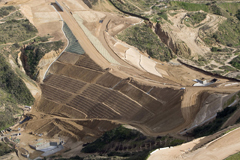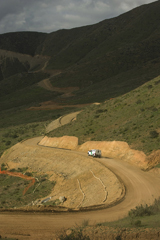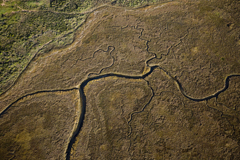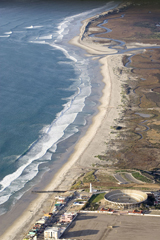By Miriam Raftery
  |
|
| © Krista Schlyer | © Roy Toft |
March 1, 2009 (San Diego) — A team of 10 international nature photographers has just completed a three-week trip from San Diego to Texas, photographing and documenting impacts that the U.S.-Mexican border wall and immigration are having on wildlife, ecology, and landscape across the Southwest. To expedite construction of a 700-mile long border fence from California to Texas, Homeland Security under President George W. Bush's administration waived all laws, including environmental protections such as the Endangered Species Act.
 |
| © Kevin Schafer |
"What we learned is it doesn't stop humans from crossing," Krista Schlyer, spokesperson for the International League of Conservation Photographers, told East County Magazine, "and it does impact the ecological systems of animals."
We spoke with Schlyer while the team was in the Barry Goldwater Mountain Range in Arizona. "The wall there goes through some really important habitat for Sonoran pronghorn and a lot of other species that really need to be able to get to water sources on other side of border," she said. "In one area, there is a solid field of mesh that is impenetrable to wildlife." The wall ended where mountains begin to ascend, she noted. "It was an important to see with our own eyes how easy it is for humans to go around it, but not for wildlife."
 |
| © Krista Schlyer
 |
In another area, the San Pedro Riparian area in Northern Arizona, she observed, "three times while we were there people cut through the steel mesh of the wall and one actually used a ramp and drove a car right through the wall." Yet she noted, "I've personally seen wildlife there at that wall trying to figure out how to go through it--javelinas and rabbits, some people have pictures of deer as well." A stark image depicts a pair of javelinas, or wild pigs, retreating from a wall soaring approximately 15-feet high.
 |
| © Krista Schlyer
 |
Schlyer added, "A a couple of landowners that have conservation ranches, easements on their land, one guy near San Pedro says he used to see wildlife all the time on his land and he just doesn't see it anymore."
Schlyer believes the wall is also blocking wildlife migration corridors and that conditions will worsen for wildlife in the future, Public Interest News Service has reported. "The animals need to be able to move to seek out food, water, shelter, and mates. In the border lands, if you put up a wall, certain species aren't going to be able to get to a water source that they've been going to for centuries," said Schlyer, who predicted global warming will increase the wall's negative impact. "As these droughts are increasing in the Southwest and as global warming continues, animals are going to need to move northward in order to be able to continue to survive. And, if there's a wall, they're just not going to be able to do that."
 |
| © Kevin Schafer |
The wall will adversely affect Arizona species like gray wolves, bighorn sheep and pronghorn antelopes, predicts Schlyer. Species in California are also at risk, but, she's especially concerned about the ocelot population in South Texas. "There is a fairly strong population of ocelots in Mexico and a struggling population in Texas. In order to increase their population, they often travel to Mexico in order to find mates, and then they'll come back into the United States."
 |
| © Jeff Foott |
Some, though not all, of the damage to wildlife could be mitigated if environmental experts were consulted, Schlyer observed. "One of our main points is had the Dept of Homeland Security had to follow environmental laws and consult with Fish & Wildlife and other wildlife scientists, they could have helped them figure out how to do this in least damaging way possible--Now it would be expensive." But even in areas where the wall has already been constructed, some mitigation is possible, such as cutting holes to allow animal movement, or modifying some structures, she added.
For example, one section of the fence is currently "really dangerous to deer and pronghorns," the wildlife photographer said. "They could try to jump over it, but there's barbed wire on the other side. These are like Normandy barriers--steel crosses on uprights angled towards the ground...Animals trying to leap over the fence could become impaled, she warned. But the group's biggest concern is over the impact on large animals, such as bobcats, coyotes, as well as ocelots and jaguars which are already rare in the United States and would be unable to cross the border for water, food, or shelter.
 |
| © Roy Toft
 |
The group, which traveled on both sides of the border, also captured haunting images of immigrants and other humans impacted by the border fence. In a diary on the photography group's website, Schlyer wrote about a cross-country trek that began in San Diego in January and ultimately included ten photographers as well as biologists and a film crew.
"In San Diego, over the past two days we have seen Smugglers Gulch, a valley in the coastal hills shared by both border towns, filled with an incomprehensible volume of dirt, in order to facilitate the building of more layers of wall. What was the gulch drains into the Tijuana estuary, a Wetlands of International Importance, as designated by the RAMSAR Treaty. And ecologists here believe the sediment runoff from this massive construction project could doom this rare estuary, a place filled with life and a quiet respite for the people of the region."
 |
| © Krista Schlyer
 |
Her blog continued, "We have also visited the Otay Mountain Wilderness, a designated wilderness that the Department of Homeland Security is now using for a staging ground for wall construction, cutting scars of roads in a landscape that was only a month ago a haven for wildlife and people." An aerial photo take by the region graphically shows the massive scale of grading and other environmental degradation.
 |
| © Roy Toft
 |
In San Diego's East County, as in many other border communities, the border fence has stirred controversy. Some area residents believe the wall provides safety from undocumented border crossers and related risks such as property damage or fires started from campfires, while human rights advocates observe that the wall has forced desperate immigrants into harsher mountain and desert terrain, increasing the death rate among border crosses. The Border Patrol concedes the wall is not able to stop people from crossing the border - only slow them down. The photographers say, while people are able to go over the wall or cut through it, many species of wildlife cannot.
"We are working with a coalition of groups like Sierra Club and Defenders of Wildlife and other groups that work on border issues," Schlyer revealed in our exclusive interview. "They will be using our photographs to approach Janet Napolitano (director of Homeland Security) and the Obama administration, hopefully very soon."
Details, video and photographers' blog here: http://www.ilcp.com/?cid=93
San Diego photos here: http://www.ilcp.com/?cid=152












Comments
border walls and environment
Thank you for this excellent story. It's also an Iron Curtain for plant species that need to migrate--critically endangered and multitudinous flora cast their seed against the neoplasticine wall, or whatever it's made of, and can no longer reproduce in the larger region they used to.